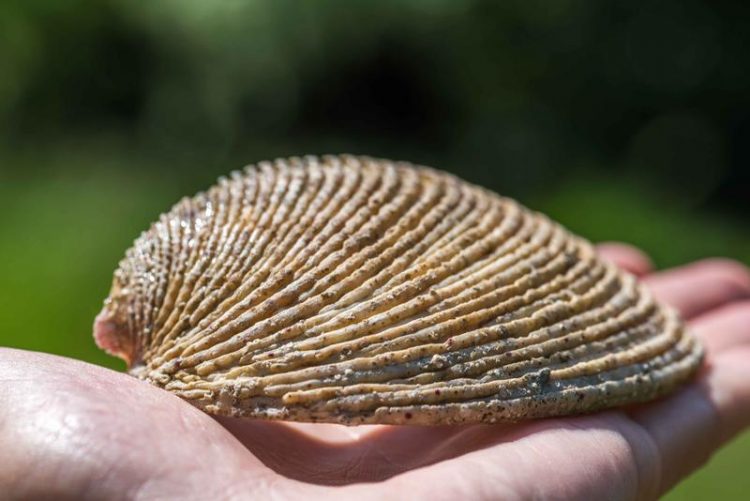How reliable are shells as climate archives?

Shell with growth rings. Photo: Tom Vierus, Leibniz Centre for Tropical Marine Research
What will our climate be like in future? Climate studies from times gone by can help scientists to answer this question. A tried and tested paleoclimatic method is the analysis of oxygen isotopes within the shells of calcifying marine organisms. They can provide insights into the temperature of the oceans or can be employed in reconstructing the rainfall in coastal regions at the time the calcified shells were developed.
For a long time the calcite shells of tiny foraminifers have been used for climate reconstruction. The shells of these aquatic single-cell organisms can be found in almost all sediments. Lately shells such as scallops or clams have also become the focus of climate researchers.
Similar to trees shells grow annual rings when their calcite exterior develops. Their chemical composition mirrors environmental conditions and gives insights into yearly or sometimes even seasonal climate changes. Large amounts of these shells can be found in particular at coastal archaeological sites, which can include deposits of thousands of years.
It is most likely that shells were heated for consumption as far back as the stone ages – even if their exterior does not necessarily show any signs of this cooking process. But are such shells still reliable climate archives?, asks ZMT- geologist Peter Müller.
Together with his colleagues he studied stone-age shell deposits on the coast of Mauretania and compared them to Venus clams from our time, which Müller cooked, grilled or burnt.
Measurements with a mass spectrometer showed that even a small amount of heat changed the composition of isotopes in the shells rendering them unusable for climate reconstructions. By measuring so-called “clumped isotopes”, a relatively new method, the team was able to differentiate precisely between heated and unheated shells.
“The method is so accurate that it even allows us to draw conclusions about the art of cooking in the Stone Age,” says Peter Müller. “We reckon that in order to open them, shells were put on hot stones that had been heated up in the fire.” Previous studies for climate reconstruction that used such prehistoric materials often did not account for that and might have come to the wrong conclusions, says Müller.
In their studies the origin of the Sahara desert was of particular interest for the team. Archaeological deposits could give an insight into the time sequence. Current theories are talking of both abrupt and slow change from lush savannah landscape to desert. Peter Müller’s dataset generated from untreated shells support the theory of a slow climate change in that respect.
Publication
http://www.nature.com/articles/s41598-017-03715-8
Contact
Dr. Peter Müller
Mobile: 0032 49 30 299 55
Mail: peter.mueller@leibniz-zmt.de
Media
Dr. Susanne Eickhoff
Leibniz Centre for Tropical Marine Research (ZMT)
Tel: 0421 / 23800-37
Mail: susanne.eickhoff@leibniz-zmt.de
About the Leibniz Centre for Tropical Marine Research
In research and education the Leibniz Centre for Tropical Marine Research (ZMT) in Bremen is dedicated to the better understanding of tropical coastal ecosystems. As an interdisciplinary Leibniz institute the ZMT conducts research on the structure and functioning of tropical coastal ecosystems and their reaction to natural changes and human interactions. It aims to provide a scientific basis for the protection and sustainable use of these ecosystems. The ZMT works in close cooperation with partners in the tropics, where it supports capacity building and the development of infrastructures in the area of sustainable coastal zone management. The ZMT is a member of the Leibniz Association.
Media Contact
More Information:
http://www.leibniz-zmt.deAll latest news from the category: Earth Sciences
Earth Sciences (also referred to as Geosciences), which deals with basic issues surrounding our planet, plays a vital role in the area of energy and raw materials supply.
Earth Sciences comprises subjects such as geology, geography, geological informatics, paleontology, mineralogy, petrography, crystallography, geophysics, geodesy, glaciology, cartography, photogrammetry, meteorology and seismology, early-warning systems, earthquake research and polar research.
Newest articles

NASA: Mystery of life’s handedness deepens
The mystery of why life uses molecules with specific orientations has deepened with a NASA-funded discovery that RNA — a key molecule thought to have potentially held the instructions for…

What are the effects of historic lithium mining on water quality?
Study reveals low levels of common contaminants but high levels of other elements in waters associated with an abandoned lithium mine. Lithium ore and mining waste from a historic lithium…

Quantum-inspired design boosts efficiency of heat-to-electricity conversion
Rice engineers take unconventional route to improving thermophotovoltaic systems. Researchers at Rice University have found a new way to improve a key element of thermophotovoltaic (TPV) systems, which convert heat…



